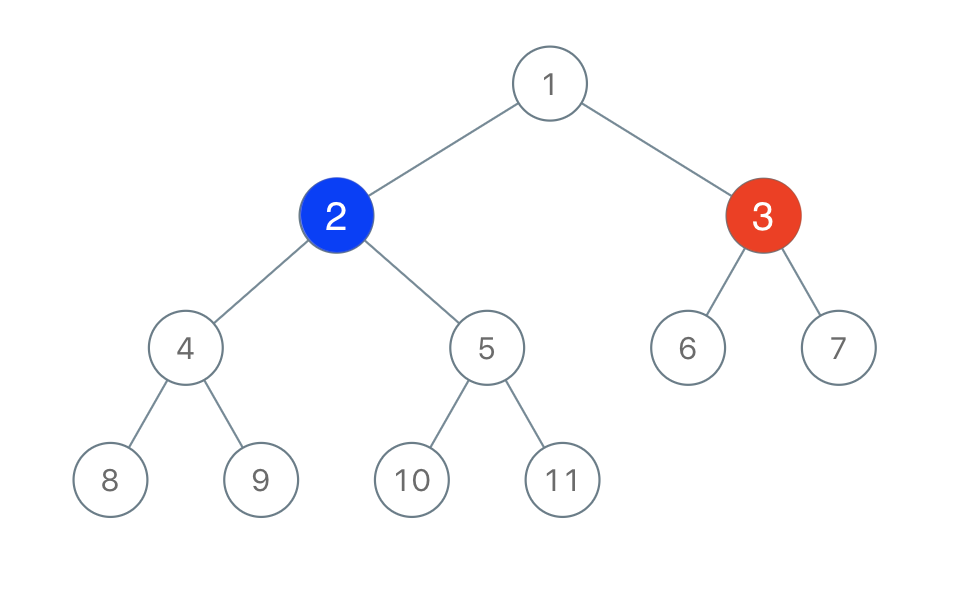Appearance
每天一道Rust-LeetCode(2019-11-13)
坚持每天一道题,刷题学习Rust.
题目描述
有两位极客玩家参与了一场「二叉树着色」的游戏。游戏中,给出二叉树的根节点 root,树上总共有 n 个节点,且 n 为奇数,其中每个节点上的值从 1 到 n 各不相同。
游戏从「一号」玩家开始(「一号」玩家为红色,「二号」玩家为蓝色),最开始时,
「一号」玩家从 [1, n] 中取一个值 x(1 <= x <= n);
「二号」玩家也从 [1, n] 中取一个值 y(1 <= y <= n)且 y != x。
「一号」玩家给值为 x 的节点染上红色,而「二号」玩家给值为 y 的节点染上蓝色。
之后两位玩家轮流进行操作,每一回合,玩家选择一个他之前涂好颜色的节点,将所选节点一个 未着色 的邻节点(即左右子节点、或父节点)进行染色。
如果当前玩家无法找到这样的节点来染色时,他的回合就会被跳过。
若两个玩家都没有可以染色的节点时,游戏结束。着色节点最多的那位玩家获得胜利 ✌️。
现在,假设你是「二号」玩家,根据所给出的输入,假如存在一个 y 值可以确保你赢得这场游戏,则返回 true;若无法获胜,就请返回 false。
示例:
 输入:root = [1,2,3,4,5,6,7,8,9,10,11], n = 11, x = 3 输出:True 解释:第二个玩家可以选择值为 2 的节点。
输入:root = [1,2,3,4,5,6,7,8,9,10,11], n = 11, x = 3 输出:True 解释:第二个玩家可以选择值为 2 的节点。
提示:
二叉树的根节点为 root,树上由 n 个节点,节点上的值从 1 到 n 各不相同。 n 为奇数。 1 <= x <= n <= 100
来源:力扣(LeetCode) 链接:https://leetcode-cn.com/problems/binary-tree-coloring-game 著作权归领扣网络所有。商业转载请联系官方授权,非商业转载请注明出处。
解题思路
- 首先树是联通的,从任意一个节点都可以走遍整棵树的任意节点
- 从任意固定节点抵达其他节点都只有一条路径,不存在多条路径的情况. 当选定x以后,树就分成了三部分,左子树,右子树和从父节点出发的路 那么就是找寻一下能否在x的这三个紧邻部分选一个y,让y覆盖的节点数多余剩下的两个之和.
解题过程
rust
use crate::share::TreeNode;
use std::cell::RefCell;
use std::rc::Rc;
struct Solution;
impl Solution {
/*
n:实际上就是树中节点的个数
采用前序遍历,碰到x后,对x的左右子树分别计数,
得到三个部分的个数即可
只要有一个部分的个数超过另外两个之和,那就应该认为我可以赢.
*/
pub fn btree_game_winning_move(root: Option<Rc<RefCell<TreeNode>>>, n: i32, x: i32) -> bool {
let mut found = false;
let (l, r) = Self::find_x(root, x, &mut found);
if !found {
//没有x
return true;
}
let path1 = l;
let path2 = r;
let path3 = n - (l + r + 1);
if path1 > path2 + path3 {
return true;
}
if path2 > path1 + path3 {
return true;
}
if path3 > path1 + path2 {
return true;
}
return false;
}
//在树中查找x,并且返回x左右两颗子树的个数
fn find_x(root: Option<Rc<RefCell<TreeNode>>>, x: i32, found: &mut bool) -> (i32, i32) {
if root.is_none() {
return (-1, -1);
}
let r = root.unwrap();
if r.borrow().val == x {
//找到了
*found = true;
let l = Self::count_nodes(r.borrow().left.clone());
let r = Self::count_nodes(r.borrow().right.clone());
return (l, r);
} else {
let l = Self::find_x(r.borrow().left.clone(), x, found);
if *found {
return l;
}
let r = Self::find_x(r.borrow().right.clone(), x, found);
if *found {
return r;
}
}
return (-1, -1);
}
fn count_nodes(n: Option<Rc<RefCell<TreeNode>>>) -> i32 {
if n.is_none() {
return 0;
}
let n = n.unwrap();
let l = Self::count_nodes(n.borrow().left.clone());
let r = Self::count_nodes(n.borrow().right.clone());
return l + r + 1;
}
}
#[cfg(test)]
mod tests {
use super::*;
use crate::share::*;
#[test]
fn test() {
let t = build_tree_ignore_parent(&vec![1, 2, 3, 4, 5, 6, 7, 8, 9, 10, 11]);
assert_eq!(Solution::btree_game_winning_move(t.clone(), 11, 1), true);
assert_eq!(Solution::btree_game_winning_move(t.clone(), 11, 2), false);
assert_eq!(Solution::btree_game_winning_move(t.clone(), 11, 3), true);
assert_eq!(Solution::btree_game_winning_move(t.clone(), 11, 4), true);
assert_eq!(Solution::btree_game_winning_move(t.clone(), 11, 5), true);
assert_eq!(Solution::btree_game_winning_move(t.clone(), 11, 6), true);
assert_eq!(Solution::btree_game_winning_move(t.clone(), 11, 7), true);
assert_eq!(Solution::btree_game_winning_move(t.clone(), 11, 8), true);
assert_eq!(Solution::btree_game_winning_move(t.clone(), 11, 9), true);
assert_eq!(Solution::btree_game_winning_move(t.clone(), 11, 10), true);
assert_eq!(Solution::btree_game_winning_move(t.clone(), 11, 11), true);
assert_eq!(Solution::btree_game_winning_move(t.clone(), 11, 12), true);
}
}
一点感悟
其他
欢迎关注我的github,本项目文章所有代码都可以找到.
 Steven's Blog
Steven's Blog